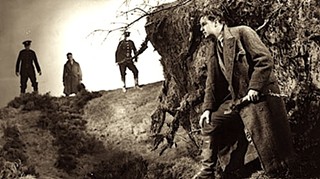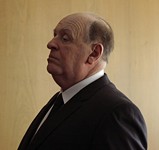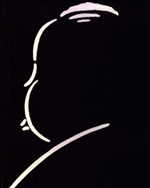How I Got Hitched
Richard Whittaker on Hitchcock when he was so very British
By Richard Whittaker, 10:00AM, Tue. Oct. 16, 2012
There are two Alfred Hitchcocks. There was the British export to Hollywood, the one that got all weird about platinum blondes. But before him, there was the man between wars, the boy from the London suburbs who grew up in a time of spies and danger and the sensuality of fear. The boy who became the man that made The 39 Steps.
Hitchcock would have been 16 when John Buchan's spy novel was first published. It was a blockbuster best seller: Richard Hannay (played in the film adaptation by Robert Donat) goes on the run after a stranger drags him into a baroque conspiracy involving stolen plans, German secret agents, and the mysterious phrase "the 39 steps." This was classic boy's own adventure stuff, the kind that I gobbled up as a child. Everyone my age had rampaged through Enid Blyton's Famous Five franchise (sort of literary Scooby Doo adventures with no ghosts and a lot more smugglers and spies), and they were a gateway drug to the more hard-nosed spy romps of the early 20th century. When I finally saw a scratched-up copy of Hitchcock's 1935 adaptation on the BBC, it was part of a tradition I already knew.
It's easy to see the roots of Hitchcock's obsession with men on the run here: But it's really the second stage in his spy sequence with script writer Charles Bennett. The duo had made cinematic history with the first British talkie, their adaptation of Bennett's scandalous Blackmail, and reunited in 1934 to throw out everything but the name for their nominal adaptation of G.K. Chesterton's The Man Who Knew Too Much. It's really a period technothriller, using rockets, photographic memory, telegrams, and the still novel ability to travel from London to Edinburgh in a day.
It's not Hitch's best film, not by a long way. It's got some great scenes, true, but they rarely hang together in a chain that spells out coherence. Buchan's original book isn't exactly a paragon of clear thinking, and depends heavily on brutish accident and coincidence to leap from one incident to another. Hitchcock's version - which, bizarrely, has now become the standard narrative upon which successor versions are based - throws much of Buchan's plot out, and brings in a whole new bucket of loopholes. The narrative is oddly lumpy, and there's incoherent character motivation that would make the crew of the Prometheus wince. Hannay spends his entire adventure trying to convince every random passerby of his cockamanie predicament.
Yet what makes The 39 Steps so special is that is so British, and it is drenched in the subtleties of empire. Hannay is a Canadian, his presence in London one of the little privileges of being part of the Commonwealth. But he has adopted all the stiff-upper-lippedness of the British gentleman, contending with gloriously miserable Scotsmen and overly-chirpy Cockneys.
There's also a deep global paranoia at play. Buchan wrote the original book in 1915, a year into the British involvement in World War One. Hitchcock and Bennett updated the novel with the fear of the dreaded Nazis over their shoulder. It's no accident that Annabelle, the mysterious woman who drags Hannay into the conspiracy, is played by Lucie Mannheim, one of Germany's most respected pre-war actresses. The character is a new creation (in the novel, Annabella is Franlin P. Scudder, and the dynamic is very different.) Like Peter Lorre, star of The Man Who Knew Too Much, she was forced into exile because she was a Jew. There's pain in her voice as she warns Hannay about the Teutonic peril outside Hannay's apartments.
It's only in the third act, when Hannay and unlikely love interest Pamela (Madeleine Carroll) are handcuffed together and surrounded by German spies, that the film finds its real spark. It's more Howard Hawks than Hitchcock, and it's the only time that Donat really gets to shine. It's really frustrating that Hannay is so poorly written for much of the movie, because Donat is now such an ill-remembered performer (check out his turn in The Winslow Boy for a remarkable insight into the post-war British mindset, or the peerless 1939 adaptation of Goodbye Mr. Chips.) But Donat and Carroll spark and flash hard enough to leave scorch marks on the Hays Code.
What gets you that far, and what Bennett and Hitchcock add, is sex. Pamela, handcuffed to Hannay in the Highlands and fight-flirting with the hero: A strand of disheveled hair floating over her eyes like a furious Marlene Dietrich, her petticoat flashing as her skirt fans a dying fire. Annabella, inviting herself into Hannay's flat after a few moments in a music hall. A young Peggy Ashcroft as a crofter's wife, demurely glancing at the dashing Hannay. Even the lascivious look on the face of a haberdasher on the train as he talks bras and bustiers (purely professional chat, of course). It's subversive in a truly British way, riddled with class and fear and easily disturbed sensibilities.
And it all ties together because it catches a time and a place and a moment. A London where one war was barely over and another was looming, where flat caps rested on bars next to top hats, and where the sense of danger overcame the old sensibilities. It was a new world, a growing world, but one where danger and peril was more present than ever.
Editor’s Note: In anticipation of Saturday’s premiere of HBO Film The Girl, about Alfred Hitchcock’s fraught relationship with leading lady Tippi Hedren, all week the Chronicle staff will be writing about their own relationships – sometimes tender, sometimes tortured – with the master of suspense.
See Marc Savlov's post about Family Plot and Alfred Hitchcock Presents here.
A note to readers: Bold and uncensored, The Austin Chronicle has been Austin’s independent news source for over 40 years, expressing the community’s political and environmental concerns and supporting its active cultural scene. Now more than ever, we need your support to continue supplying Austin with independent, free press. If real news is important to you, please consider making a donation of $5, $10 or whatever you can afford, to help keep our journalism on stands.
Marjorie Baumgarten, Dec. 7, 2012
Kate X Messer, Oct. 20, 2012
June 13, 2025
June 13, 2025
Alfred Hitchcock, How I Got Hitched, The 39 Steps, John Buchan, Robert Donat











